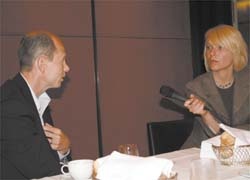What's your prediction for MR? 'Expect the unexpected'
Since April, there's been a new man at GE Healthcare´s global MRI division; its new Vice President and General Manager is James E Davis. Meike Lerner caught up with him during the International Society for Magnetic Resonance in Medicine Congress, held recently in Berlin

[Bild-1]‘Mr. Davis, what do you expect from the magnetic resonance (MR) technology in the near future and what are you aiming for?’
James Davis, newly appointed VP and General Manager of GE Healthcare’s global MRI division, responded with little hesitation: ‘Some of the most promising uses of MR will centre around breast imaging, the prostate and liver imaging. Going another step forward, the use of MR for whole body imaging - for cancer and metastasis detection - will offer us unique possibilities considering our early health philosophy. I think, today, we’ve only tapped 30% of MR potential, and it will keep going with breakthroughs that we can only dream of today. Look at the amazing possibilities molecular imaging offers us: MR is at its heart a modality that enables us to use it for functional imaging studies, to analyse the metabolism of tumours and cancer.
‘One example is the so-called hyperpolarised carbon 13 technology, which has been in development with GE for two years. With this unusual technology we can boost the signal from magnetic resonance maybe 10,000 or 100,000 times, and therefore see things in the body that have been invisible so far. This offers the potential to watch metabolic reactions in certain locations of the body and turn MR into a modality for probing the body’s metabolism in ways that were previously impossible beyond the test tube. For us, this is the greatest potential for MR in molecular imaging.
‘Another important use of MR is and will be in cardiology. Here, MR is one of the most efficient diagnostic systems. There are several studies, particularly in Europe, in which we are trying go characterise coronary plaque, which means looking at the signals returning from the plaque. They would tell us if it is a harder calcified plaque or a softer vulnerable one, which is very important information in terms of treatment options.
Beyond those promising perspectives, there are problems such as MR-regulation discussions in Europe, and the negative effects of the gadolinium-based contrast agents. Asked how GE Healthcare is dealing with these, James Davis replied:
In relation to the condition known as Nephrogenic Systemic Fibrosis (NSF) GE Healthcare is working with global health authorities and engaged in a variety of clinical and pre-clinical activities to better understand this serious condition. In consultation with the EMEA CHMP, FDA and other authorities, GE Healthcare has made modifications to the prescribing information for gadolinium containing contrast agent related to NSF and is committed to keeping our customers fully informed about using our products in the safest and most effective manner.
‘Looking at the planned EU regulation that deals with the protection of those working in a surrounding of magnetic fields, we are very concerned. Primarily because we have not seen any scientific evidence that indicates that the kind of exposure the medical community get to magnetic signals and EMF signals cause any problems. But for us, as a provider of medical equipment, it is important to ensure that our technologies are as safe as possible. So, of course we are open to working with the medical community on studies and tests to really see if there are any clinical evidences that exposures to EMF signals generated by MR equipment could be a problem. So far, we have not seen it, but we seriously care about this.
In summary: All these things we talked about today are still just a small piece of possibilities and challenges we will face in the future. Talking about MR means to expect the unexpected. There will be great medical advances that today we don’t expect. There will also be problems that we cannot foresee today. But I’m sure MR will have a great future in medical diagnostics.’
26.06.2007











